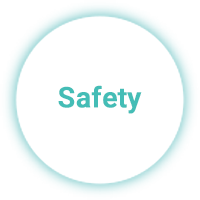Health Know-how
Pulse Oximeter
What does blood oxygen saturation (SpO2) have to do with my health?

Many diseases with no external symptoms can lead to hypoxia, and as general hypoxia is not easily detectable, the condition is also called “Silent signs” or “Happy hypoxia”.
As a result, regular measurement of blood oxygen saturation (SpO2) can detect the presence of silent signs, and thus discover potentially serious cases early. Chronically ill or critically ill patients can prevent conditions from deteriorating in advance by measuring changes in blood oxygen saturation (SpO2) .
What is blood oxygen saturation (SpO2) ?

Blood oxygen saturation (abbreviated as SpO2), or blood oxygen level, is one of the most important essential data in clinical medicine.
The body primarily consumes oxygen from the oxygen carried by haemoglobin. There are four types of haemoglobin in normal blood.
From these, the one that reversibly combines with oxygen is reduced haemoglobin (Hb), and the ones that do not combine with oxygen are carboxyhaemoglobin (CoHb) and methaemoglobin (MetHb). The blood oxygen level usually refers to the amount of oxyhaemoglobin (HbO2) in the blood, using blood oxygen saturation (SpO2). This physical quantity describes the change in blood oxygen content.
Clinically, the functional saturation is often used to reflect the change of oxygen content in blood oxygen.
Ischemic Heart Diseae
What does blood oxygen saturation (SpO2) indicate?

Blood oxygen saturation (SpO2) represents a measure of how much oxygen the red blood cells contain. If the reading is too low, it may indicate the presence of a disease, such as the heart defects, circulatory problems, asthma or lung disease. Therefore, maintaining healthy blood oxygen level is essential.
The reading shows the blood saturation, and a normal reading is usually between 95-100%.
Symptoms caused by different blood oxygen saturation level (SpO2)
| Cardiovascular system | Respiratory diseases | Nervous system | |
|---|---|---|---|
| Mild or moderate hypoxia | Shortness of breath Difficulty breathing Paleness | Fast heart rate Mild hypertension Vasoconstriction | Anxiety Disorientation Headache and dizziness Fatigue |
| Severe hypoxia | Shortness of breath Difficulty breathing Black or purple skin or nails | Heart rate that is either too fast or too slow High or low blood pressure | Drowsiness Unconsciousness Blurred vision Coma |
| Cardiovascular system | |
|---|---|
| Mild or moderate hypoxia | Shortness of breath Difficulty breathing Paleness |
| Severe hypoxia | Shortness of breath Difficulty breathing Black or purple skin or nails |
| Respiratory diseases | |
|---|---|
| Mild or moderate hypoxia | Fast heart rate Mild hypertension Vasoconstriction |
| Severe hypoxia | Heart rate that is either too fast or too slow High or low blood pressure |
| Nervous system | |
|---|---|
| Mild or moderate hypoxia | Anxiety Disorientation Headache and dizziness Fatigue |
| Severe hypoxia | Drowsiness Unconsciousness Blurred vision Coma |
How does a pulse oximeter work?

Pulse oximeters are non-invasive devices that can measure oxygen levels in the blood. They use red light (660 nm) and infrared light (910 nm) transmitted to the capillaries of the finger to calculate the amount of light reflected in the blood. When measuring blood oxygen, the difference between reduced haemoglobin and oxygenated haemoglobin is the most basic data for measuring blood oxygen saturation (SpO2) by detecting the difference between the two kinds of light absorption at different wavelengths.
Haemoglobin concentration and oxygen saturation are calculated by measuring the density of light transmission in the tissue.
What is the pulse rate?
Pulse rate is the number of pulse beats per minute, with the pulse referring to beats of the superficial artery. The pulse rate and heart rate are normally the same.
Normal heart rate: The heart rate is the frequency of heart beats. The heart rate for the average person is between 60-90 beats per minute; and during exercise or if under strain, the heart rate will increase.
The pulse rate will be lower than the heart rate when atrial fibrillation or other problems cause an irregular heart rhythm.

Self-testing

The World Health Organisation has highlighted in its publication “Clinical Management of COVID-19” that oxygen therapy is the main treatment for patients with severe COVID-19.
The pulse oximeter manages blood oxygen saturation (SpO2) and pulse data of COVID-19 patients through remote real-time monitoring.
By transmitting blood oxygen data through smart products, the oximeter not only improves efficiency of diagnosis and treatment by medical personnel, but it also reduces the likelihood of secondary infection.
Why choose medisana pulse oximeter with MDD certification and ISO certification?

Safety
All structural parts in contact with the fingers have passed the ISO10993 biocompatibility test to avoid allergies during application

Stability
The design of the reliable electronic components ensures the stability of performance and the accuracy of readings

Durability
The body of the product is made of an anti-wiping injection molding material, which has passed thousands of wipe tests to meet the requirements of daily use and disinfection

Reliability
The sensor is sealed to effectively avoid sweat from fingers affecting performance during use











